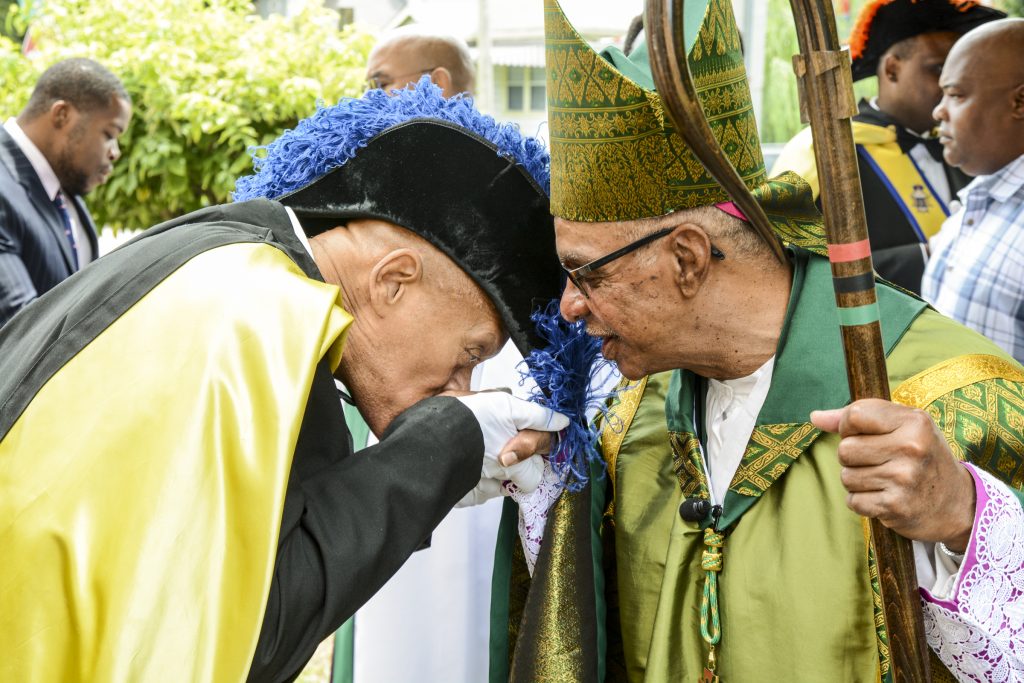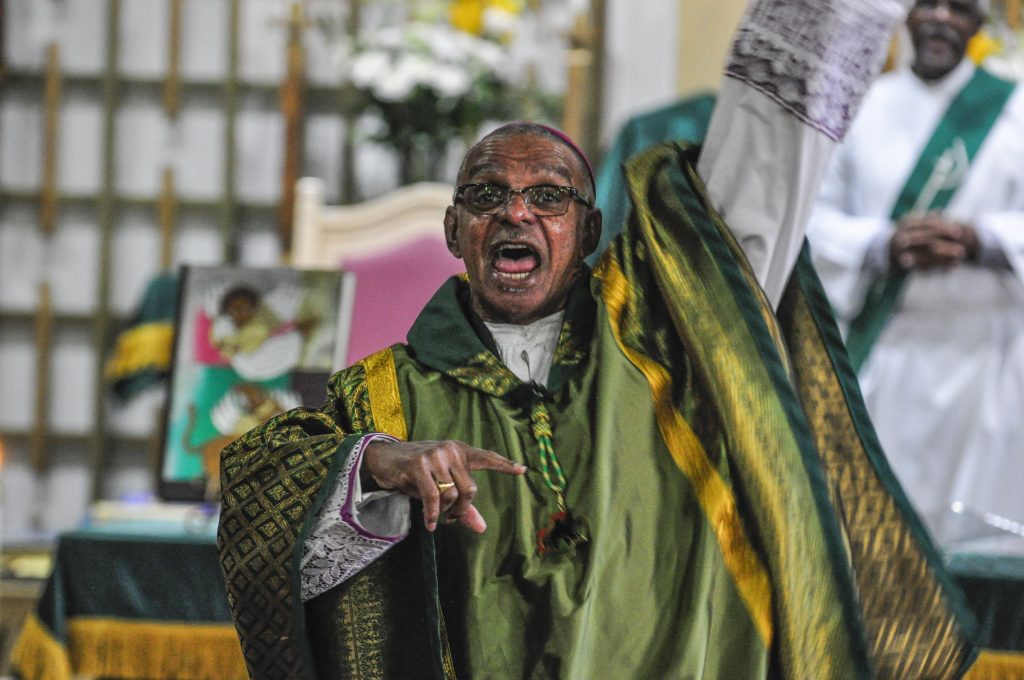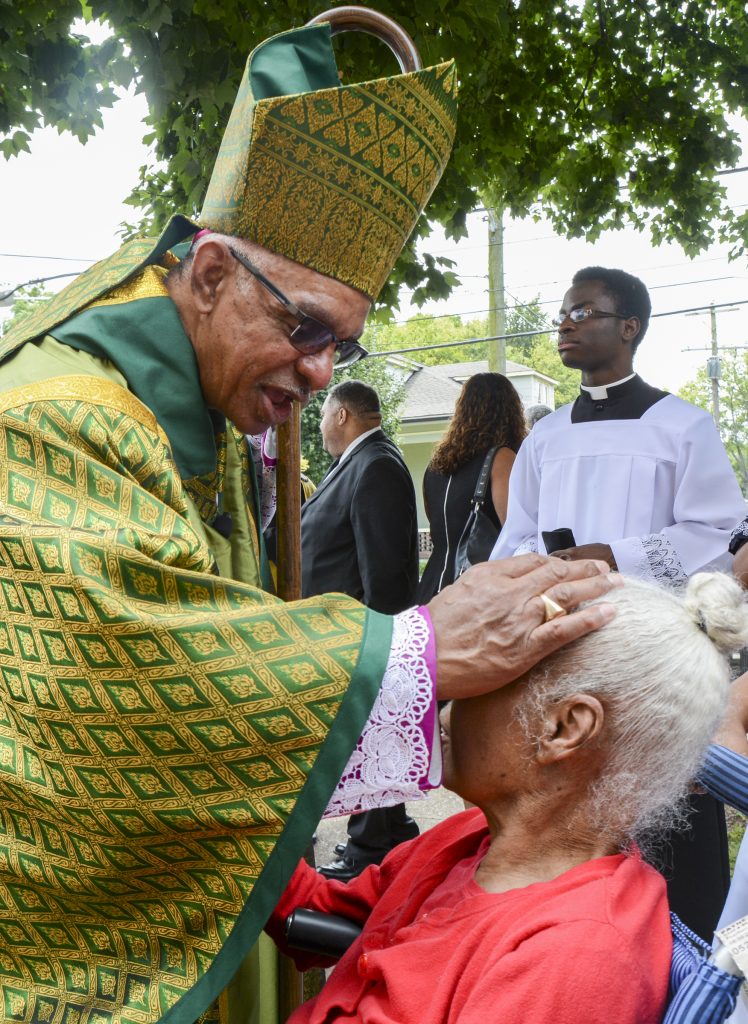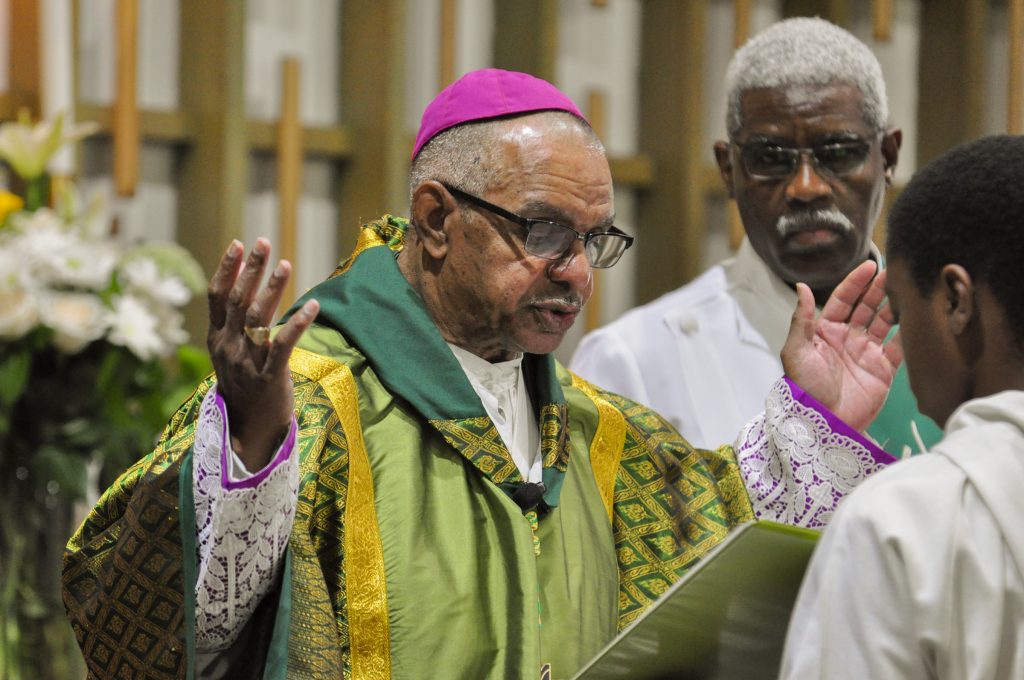
Bishop Fernand “Ferd” Joseph Cheri III, OFM, auxiliary bishop of New Orleans and former pastor of St. Vincent de Paul Church in North Nashville, passed away on Tuesday, March 21, at Chateau de Notre Dame in New Orleans, following a long illness. He was 71.
“It is with sadness, prayer, and reflection that I inform you today of the death of Most Reverend Fernand Joseph Cheri, III, OFM,” said Bishop J. Mark Spalding in a statement posted to social media. “Bishop Cheri served as the Auxiliary Bishop for the Archdiocese of New Orleans. Eternal rest grant unto him, O Lord, and let perpetual light shine upon him. May he rest in peace. Amen.”
Solemn Vespers will be at 5 p.m. on Friday, March 31, at Notre Dame Seminary in New Orleans, with a visitation immediately following from 5:30-8:30 p.m. A visitation will also take place from 9-11 a.m. Saturday, April 1, at St. Louis Cathedral in New Orleans, with a Mass of Christian Burial immediately following.
Bishop Cheri was a native of New Orleans, Louisiana, who served in several capacities for the Archdiocese of New Orleans following his ordination to the priesthood on May 20, 1978, developing strong music ministries wherever he went.
Then, in the early 90s, Bishop Cheri began to feel called to join a religious community.
“I was toying with the idea because I was living alone, and I had some nights when I just wished I could talk to somebody about stuff,” Bishop Cheri told the Clarion Herald, the official newspaper of the Archdiocese of New Orleans. “You can call a friend, but it’s different when you’re eating with somebody and can share your day, and what’s going on in your life.”
After making some inquiries to various religious communities, Bishop Cheri settled on the Franciscan Friars “because of St. Francis and his idea of service to the poor, the marginalized, the variety of possibilities of working with the homeless people or in prison ministry. I felt I wanted to do something other than just parish ministry. The Friars offered that possibility to me. I also knew a lot of Black Friars who were working around the country. I thought this might be a good fit.”
Bringing His Love of Music
Working around the country is just what he went on to do after joining the order and it eventually led him to St. Vincent de Paul Church in North Nashville, for which he served as pastor from 1996 to 2002.

Bishop Cheri “was an interesting figure and one of the best preachers I’ve ever heard. He is a noted revivalist who preaches across the country drawing his strength and testimony from God’s word in Scripture,” said Deacon Bill Hill of Holy Family Church in Brentwood and formerly of St. Vincent de Paul Church. “Bishop Ferd was known for working in populations of the most severely disadvantaged individuals in society and making an impact, especially in teaching others how to deal with conflict in a Christian manner.”
Deacon Hill noted the revitalization that Bishop Cheri brought to St. Vincent de Paul.
“He came in with a different style of music and even though some of the older parishioners didn’t like it, he doubled the attendance. Music was his thing,” Deacon Hill continued, noting his contributions to multiple songbooks including the “African American Heritage Hymnal, 2nd Edition.” “To him, music can really enhance the liturgical celebration.”
Elaine McReynolds, who has been a parishioner of St. Vincent de Paul since 1970, also recalled the revitalization that Bishop Cheri brought musically.
“He brought old-fashioned revival to a Catholic Church. He was music. He loved music,” McReynolds said. “He didn’t just listen to music. Music just operated through him, and because of that and his magnetism, it operated on us, and it was great.
“The level of spirituality that we experienced with Father Ferd quite frankly was unparalleled,” she said. “My husband, George and I really loved him. We loved him not only as a priest, but as a brother, as if he were truly a member of our family.”
The revitalization that Bishop Cheri brought to the church continues through this day with a traditional style of worship music at the Sunday 8:30 a.m. Mass, but then an upbeat style at the Sunday 11 a.m. Mass, Deacon Hill said.
“It’s just real upbeat, and the young people are attracted to the upbeat music,” he said.
Go Down Moses
Deacon Hill said that Bishop Cheri was also instrumental in building the new school building for St. Vincent de Paul, which opened in 1998.
“When he came in, he definitely revitalized things,” Deacon Hill said. “One of his biggest achievements was building the new school.
“I remember, he appointed me and Dr. Stella Simpson as co-chairs of the building committee,” he continued. “We were friends, but he told me one time that I should give a little bit more to the building fund. I thought I had given quite a bit already.
“I told him, ‘You can’t tell me to give more to the building fund if you haven’t given anything,’” he recalled. “As a result, he did start giving money, which changed in a lot of ways how things have usually been done.”
Deacon Hill said Bishop Cheri had many reasons for wanting to make sure a new school was built to continue to serve Black youth in the diocese.
“He wanted the education piece. He thought that Nashville needed a Black Catholic School to educate people and teach them morals, but also to evangelize. He wanted leaders who go in and come in and speak up,” Deacon Hill said. “One of his missions was to make the broader Church aware of the contributions of Black Catholics to the Church and also to try and integrate the gifts of Black Catholics into the Church, especially in terms of the liturgy.”
To further assist Black youth, Deacon Hill said Bishop Cheri also started the Go Down Moses program for youth.
“His big emphasis was on Black youth and Black identity. That was his thing,” Deacon Hill said. Go Down Moses “was a program to try and help Black youth deal with life and also try and get some of them to think about religious life.”

A beautiful friendship
There was one youth in particular who was touched by Bishop Cheri and vice versa.
Caleb Sanders was about 11 years old when he and his parents, Mary and Ken Sanders, joined St. Vincent de Paul in 1999. It was then that he began altar serving.
“Bishop Ferd always considered Caleb his server,” said Mary Sanders. “They had a very unique relationship in that Caleb was always very inquisitive and loved the Church, so he gravitated toward Bishop Ferd, asking him questions, and he would provide the answers.”
Even after Bishop Ferd left St. Vincent de Paul, the family kept in touch with him, and when Caleb was diagnosed with brain cancer in September 2011, Mary Sanders said called Bishop Cheri just to let him know and “so he could pray for him.”
After the initial diagnosis, Caleb Sanders underwent surgery and was doing well for the next year, until the tumor returned in 2013. Then, in June 2013, it was determined that there was no more medication that could help Caleb. Once again, Mary Sanders called Bishop Cheri, who was in St. Louis, Missouri, at the time, to keep him abreast of the situation.
“He said, ‘I’m on my way. I’m coming to see him,’” she said. “Sure enough, he showed up, and he didn’t tell anybody else in Nashville that he was coming because this was all about Caleb.”
When he arrived, he sat with Caleb and issued last rites for him, and Mary Sanders immediately realized a change in her son.
“He lost his fear. I’m not so sure he ever really voiced that he was scared to die, but you could tell that after Bishop Ferd gave him his last rites that Caleb was just at peace. It was such a gift to give him,” Mary Sanders said. “Because of that relationship that they had built and the love that they had for each other, I just think that’s what created that calm and that peace that came over him. No one else could have done that for Caleb.”
Caleb Sanders passed away six weeks later on July 31, 2013.
One year later, Bishop Cheri called Ken and Mary Sanders with the news that a stone, with Caleb’s name on it, would be commissioned at the Bishops’ Lyke Conference in New Orleans. The conference is an annual liturgical event that brings together Black Catholics to be trained in African-American patrimony. The stones at the event, which contain two names each of those who are considered to embody what it means to be a follower of Christ. These stones surround the sanctuary during the event.
“You walk around, and you look at these names of people who have been leaders in the Catholic Church, and Bishop Ferd put our son’s name on one of those stones. That’s how he thought of him, that our child was very important to the Catholic Church,” Mary Sanders said. “Bishop Ferd said he had to fight to get this done because the other members of the conference were questioning it. They said, ‘You’re just talking about a kid who was an altar server.’ Bishop Ferd said, ‘He’s my altar server.’
“He had to have said a lot of very wonderful things about Caleb for the whole committee to decide he’s worthy to have his name on one of the stones,” she said. “But that’s the kind of person Bishop Ferd was, and we love him dearly.”
Standing up for Black Catholics
Deacon Hill said Bishop Cheri was also very active in pursuing the rights of Black Catholics.
“He was just very, very attune to things in the Black community, problems in the Black community, and he came in with good suggestions for problems in the Black community,” he added. “Bishop Ferd constructively addressed the idea of internalized racism in the Church and encouraged his parishioners to be validly Black and justly Catholic. He was passionate about serving God and making Black Catholic Church a means of salvation for the whole Church and the world.
“He respected everybody, but if you crossed a line he would tell you, no matter who you were, though usually in a nice way,” he continued. “When he was extremely frustrated, he would throw his arms into the air, say, ‘It’s all for the Kingdom,’ and smile.”
On the other hand, “Bishop Ferd wanted to do things his way, but he realized that it only works when you work with the people,” Deacon Hill continued. “He was very good at surveying parishioners and then getting their buy-in. If they didn’t agree, he would not do it.”

Remembering his people
Even after Bishop Cheri left St. Vincent de Paul, Deacon Hill recalled how he never forgot the places he served, particularly when it came time for his ordination as auxiliary bishop on March 23, 2015, at St. Louis Cathedral.
“I served as a deacon during the ordination Mass, which brought home the point that he remembered his parish and the people at St. Vincent that he worked with,” Deacon Hill said. “It was one of the most wonderful things I’d ever experienced, other than my own ordination.
“The pomp and circumstance and everything that went on there, it was amazing. I don’t think I’ll ever experience another thing like it,” he said. “Everybody was there, everybody was happy, everybody was moved, and I thought it was really beautiful.”
Even following his ordination as auxiliary bishop of New Orleans, Bishop Cheri made a few trips back to St. Vincent de Paul to celebrate Mass with his former parish community.
“He really liked to come and be with the people,” Deacon Hill said. “And we always loved having him back.”
“The world has lost a great human being,” McReynolds added. “Father Ferd went over and beyond all the time, every day. There was nothing too great or too small for him to do. He was just extraordinary.”









